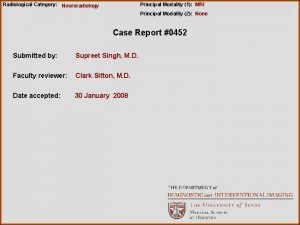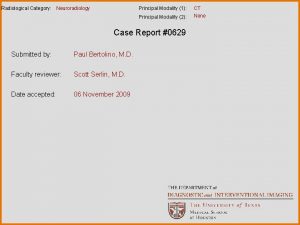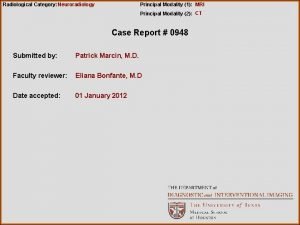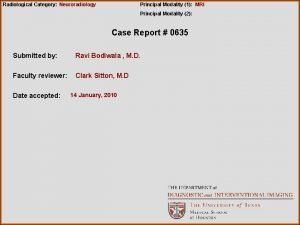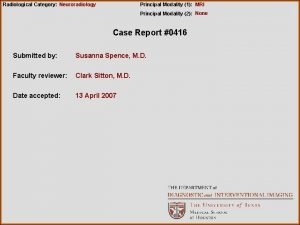Radiological Category Neuroradiology Principal Modality 1 MRI Principal









- Slides: 9

Radiological Category: Neuroradiology Principal Modality (1): MRI Principal Modality (2): None Case Report #0251 Submitted by: Virginia Scroggins , M. D. Faculty reviewer: Clark Sitton, M. D. Date accepted: 15 January 2006

Case History Seizures and hormonal imbalances.

Radiological Presentations Axial T 1 Sagittal T 1 Coronal FLAIR Axial FLAIR

Radiological Presentations Sagittal Pre. Contrast T 1 Sagittal Post. Contrast T 1 Coronal Post. Contrast T 1

Test Your Diagnosis Which one of the following is your choice for the appropriate diagnosis? After your selection, go to next page. • Craniopharyngioma • Optic glioma • Hypothalamic hamartoma

Findings and Differentials Findings: MRI reveals a well-circumscribed mass eccentrically located in the region of the hypothalamus. The mass is iso-intense to gray matter on T 1 weighted images and hyperintense to gray matter on T 2 weighted images. Post-contrast images demonstrate no significant enhancement. Differentials: • Craniopharyngioma • Optic glioma • Hypothalamic hamartoma

Discussion Hypothalamic hamartomas are also known as hamartomas of the tuber cinerum. They are congenital malformations of normal brain tissue lodged in an abnormal location. They are not true neoplasms. These lesions are typically small pedunculated growths contiguous with the posterior hypothalamus, between the tuber cinereum and mammillary bodies. They fill the free space between the optic chiasm and pons.

Discussion Patients typically present with precocious puberty. Other symptoms include visual disturbances and the characteristic “gelastic seizure”, or laughing seizure. These masses are homogeneous and iso-intense to gray matter on T 1, and hyperintense to gray matter on T 2 imaging. They do not enhance. The anatomic location together with the signal characteristics is strongly suggestive of the diagnosis. The optic nerves and chiasm are separate from the mass, excluding an optic nerve glioma. Craniopharyngiomas often have calcifications, cystic components and hemorrhage, a feature lacking in these hamartomas. Hyypothalamic gliomas typically enhance after contrast. The long term stability with failure to grow and continued lack of enhancement would support the diagnosis of hypothalamic hamartoma. Shah P, Patkar D, Patankar T, Shah J, Srinivasa P, Krishnan A. MR imaging features in hypothalamic hamartoma: a report of three cases and review of literature. J Postgrad Med 1999; 45: 84 -6

Diagnosis Hypothalamic Hamartoma






